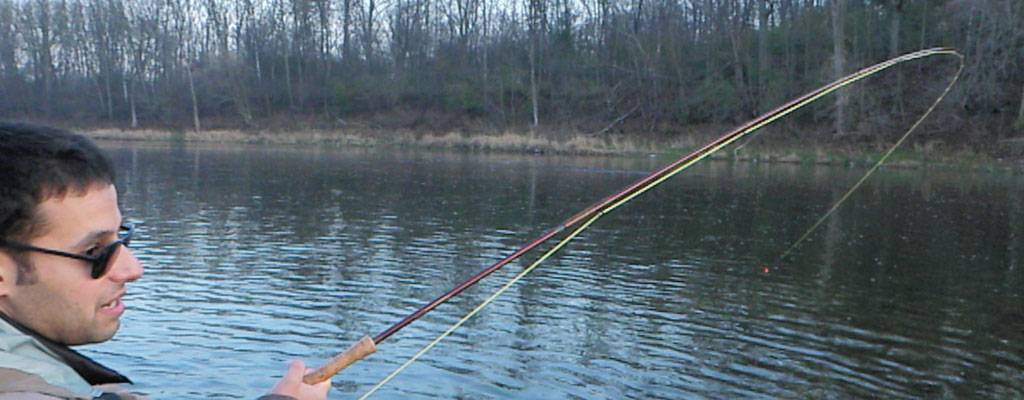
Extreme Nymphing
by Steve May and Ken Collins - December 1, 2005
Whether you are fishing a tumbling freestone river in the west or chasing Great Lakes steelhead, there are times where getting a good nymph presentation down to the fish in heavy water is the difference between a hero day and going home with only memories of the beautiful scenery. Being able to rig and fish nymphs effectively is the best way for most anglers to improve their success on the water day in and day out.
With a better understanding of nymph fishing and how to rig effectively for this specialized type of fishing, you can enjoy the scenery and catch a lot more fish on your favourite river. I have worked with fellow guide and mentor Ken Collins of Grand River Troutfitters to develop a nymphing system that has worked incredibly well for our clients whether we are fishing for Grand River brown trout, Great Lakes steelhead or river smallmouth bass.
Effective nymph fishing starts with a good leader rig. It is surprising how many anglers fail to consider their rigging. They have the best rod, a flawless drag to their reel and a suitcase full of proven flies yet any old leader will be tied on the end of their fly line! And when they are going after big fish they get out the heavy leaders! What a mistake! The leader is an integral piece of a nymph rig system.
Traditional tapered leaders are great for turning over flies and making delicate presentations. However, there is nothing delicate about nymphing in a turbulent river. What is needed is a leader that sinks fast and can get your fly to the bottom and to the fish pronto. A good leader rig must also be flexible because each pocket may require changing your eight or leader length.
Ken and I have put our heads together and over the past several seasons developed a nymphing system that works like a charm for steelhead nymphing on our Great Lakes streams and many more applications.
The leader we use is a little unorthodox. It is a variation on the "right angle" nymphing philosophy but the “Extreme Nymphing Rig" provides much more versatility and ease of adjustment. This rig consists of a heavy butt (usually 0.019" monofilament) with an adjustable strike indicator attached. To this leader butt a lighter mid section is tied in with the help of a small swivel (usually 3X fluorocarbon tippet). Then at the other end of the 3X mid section of the leader, the tippet is attached with the help of another swivel. Swivels reduce line twist and allow you to tie stronger knots. A dropper on the lower swivel is used to attach the shot to the system. This rig is one that was developed through "a comedy of errors". But the resulting "Extreme Nymphing Rig" has helped us and our clients catch a ton of fish.
Ken discovered the key element of this rig on a local steelhead river a few years ago. This small freestone river is full of large boulders, quick drops and pocket water that are magnets to migratory fish. In Ken's haste to get to the river he packed a little light. The one beat up leader he had was tied to the end of his line. After an hour or so of fishing he lodged his rig between a couple of sharp rocks and his 9' leader was suddenly about three feet long. A little short and heavy for the conditions at hand! Without the materials to rebuild a compound tapered leader in his vest, he could not rebuild his leader the way he wanted to, so he improvised. A small swivel borrowed from a float fishing friend and some 3x tippet were put into service. With this improvised leader, he fished the rest of the afternoon and did surprisingly well. The person he was fishing with didn’t get a sniff and Ken beached half dozen nice fish in a couple of hours. So Ken began wondering, why did that leader work so well.
The main reason was that thinner line sinks faster than thicker line. When you are working small pockets, getting the fly down quickly is paramount. If your fly sinks faster, it will be in the faces of many more fish over the course of the day. If they are holding tight to the bottom around boulders, you may not be able to get a fly to them with a traditional tapered leader. A thinner mid-section to the leader really helps your rig sink. You also need less weight to get your fly down to the fish with a thinner leader. Or, if you use heavier weight it will get down way faster than is possible with a traditional tapered leader.
The little swivel may not seem like traditional fly-fishing tackle, but it is monumentally important to the performance of this rig. First it allows you to tie 100% knot strength knots at these key leader transition intersections and secondly the ability to join 30lb butt material to 8lb mid section material. Tying to a swivel also allows you to tie stronger knots with cold hands. Palomar and improved clinch knots are both stronger and easier to tie than blood and surgeons’ knots. The swivel worked so well that we also incorporate it at the junction between the leader’s mid section and the tippet. The swivels add a bit of weight to help sink the fly and reducing line twist in your leader so nasty tangles are less common.
The lower swivel was also handy for adding a short piece of mono-filament as a dropper to place shot on. The dropper shot system allows shot snagged on the bottom to slip off of the dropper freeing your rig and often saving your fly. In addition, the amount of shot on the dropper is easy to adjust.
Another emergency improvisation resulted in an improved way to rig the indicator. I used to use an indicator pegged in place with a small peg or toothpick. One day I lost my last peg and was wondering how I should fix my indicator in place. After carving bank side twigs failed, I tried looping the line through the indicator twice. On the thick leader butt material, it wouldn’t compromise the strength of the leader and what resulted was an easily adjusted indicator that stayed exactly where I wanted it to. I have not bought or used pegs since that day. If you use Thill Bite n fly (corky style) indicators with a plastic liner, they will last for most of a season of hard-core steelhead nymphing.
So now we have leader that we can easily adjust for dept and amount of shot. This leader sinks flies quickly to the bottom and is easy to repair in the field in only a minute or two with a limited amount of materials. This simple rig allows anglers to concentrate on fishing a lot more than on rigging. The rig can be adapted to finesse nymphing for spooky tailwater brown trout or to get your flies down to fish holding in deep fast runs of the mighty Niagara River. It really is an incredibly versatile nymph leader style. A prepared angler might carry two pre tied rigs a shallow and a deep model. We stock and sell 3 models: Shallow water (3ft-5ft) Most Common Depth (4ft-7ft) and the Deep System (6ft-10ft)
Rigging Formula
The mid section of your leader should generally be tied so that it matches the shallowest water you will be fishing. The leader butt section will allow you to adjust to deeper locations you will encounter. This leader works best when it sits quite vertical in the water. For this reason the distance between the swivels should never be more than 1.5 times the water depth. I usually like to have 1.25 times the water depth in slow or medium flows and at 1.5 times in faster current areas.
Tippet Section
Tippet length can vary depending on the water clarity and the depth you are trying to get your rig. The deeper you are making a presentation and the more off colour water, the shorter the tippet can be. I have success in stained water with tippets of 8”-10”. However, a tippet of 12” – 18” seems to provide a more natural drift. To avoid foul hooking fish, your tippet should be kept as short as possible. Your tippet never needs to exceed two feet long. If I am running two flies I usually have the first about 12” form the split shot and the trailer fly tied of the hook bend of first fly with about a 8” lead.
Effective Fly patterns
With a specialized leader like the extreme nymphing set-up, that helps punch flies to the bottom it is wise to use flies that are easy to sacrifice to the fish gods. You will be surprised at how many really good fish come out of oddball locations because you are putting flies into places where losing them is a distinct possibility. I often fish in spots like deep log jams and boulder fields that others are afraid to play in because of the high probability of lost tackle.
Depending on what species and where you are fishing, fly selection will vary. For steelheading, I use a lot of egg patterns. Egg flies “match the hatch” catch tons of steelhead and are incredibly easy to tie. I also use a lot of simple nymph patterns and woolly buggers when chasing migratory rainbows.
For trout, I continue with the match the hatch philosophy. Unweighted nymphs like Pheasant Tails and Gold Ribbed Hare’s Ears seem to drift with the current better and have more natural movement when I am fishing calmer flows' Caddis Larvae also work well and meet the "effective and easy to tie" criteria. When the water is turbulent or off colour, I often shorten the tippet and use flies that incorporate a bead head and other forms of weight. Bolder Woolly Buggers also excel when used with the extreme nymphing system when you need to put a big offering down in front of the fish.
When fishing smallmouth bass or big browns in deep slow pools, I like to use flies with a bit more motion. Buggers and leeches are a standby as are Full Motion Hexes, Full Motion Crayfish and Possie buggers. These bead head patterns with flowing materials excel at deep slow nymph presentations.
Presentation Basics
It is one thing to have the correct leader and to know how to adjust it. You then have to be able to use this leader to make an effective presentation.
The Cast
Casting a heavily weighted nymph leader with a couple of definite hinge zones built into the leader means that false casting can cause some interesting tangles that can take a lot of fishing time to untangle.
A "water loaded" cast is best with this rig. To accomplish this, point your rod downstream and make sure the line is taut. Then smoothly swing the rod towards the bank behind you keeping it low to the water. Then flip it over your head pointing it out into the river where you want your rig to end up. With a little practice, you will get pretty good at placing your rig upstream of you right into a fishy looking current lane. This method limits how far out into the river you can get your rig. I generally feel that I can work out about two and a half times the rod length with this method.
A smooth open loop cast can also be used to get the rig out further. Longer rods can be incorporated to help extend your range and help to mend line effectively at a distance. Some Spey style casts like the Double Spey can be very effective with this set-up. Remember, these advanced “roll casts’ work well with single handed rods and longer double handed switch rods. I have even incorporated a 14” Spey rod with a giant bobber once or twice and that allowed me to fish the Niagara river effectively. Regardless of the casting method you generally want to make a nice smooth and fluid cast upstream of the area where you feel the fish are holding.
Stage One – Presentation -- Sink and Set-up zone
This is the part of the presentation where you allow things to get down to the fish. After the cast, I usually pause to let things sink and then make an upstream mend to get the line upstream of my indicator and ready for the next and most important stage of the presentation. A the end of the sink zone, you should have your rod tip high and pointing a little upstream, preparing to put light tension on your rig (or as my mentor Ken calls it “Magic Tension”) as the flies start to enter the sweet spot you are looking to fish. If you set things up properly a good presentation will result. Without this preparation, the rest of the presentation is tough to get right.
Stage Two – Presentation --Fishing Zone
I also call this the ‘hold back and follow through zone” because that is what you are really doing. In this phase of the presentation, you are keeping a slight tension (“Magic Tension”) on your line and following the indicator through the drift. This accomplished a couple of things. First it will slow down the progress of your indicator slightly. It is important that your presentation goes slower than the current. You can easily see this by comparing your indicator drift down stream in comparison to other floating bubbles. This is important because river currents are almost always slower at the bottom that the top of the river column. When you are fishing a nymph, you want it to be ‘drag free’ at the bottom, and not necessarily on the surface like a dry fly. In addition, it can help identify strikes better and help you react quicker to set the hook or pull your flies away from the bottom obstructions. Another advantage of holding back your rig is that the fly is the first thing the fish sees. It is not hit on the head with your shot or leader before it sees the fly. This almost eliminates the possibility of ‘flossing‘the fish, which is easy to do with extra long leaders and non controlled drifts.
As the indicator floats downstream, your rod tip should follow it down the river. During this phase of the presentation you need to be aware of any changes in the drift of your indicator. If it twitches, pauses abnormally or you just think something is wrong, initiate a hook set with a smooth short pull of the rod downstream.
I like to set the hook in two stages. The first phase I call the investigative or dislodging hook set. This first phase see me tug on the rig to dislodge it from the bottom obstructions with a firm but smooth downstream tug on the rig. A dislodging hook set may just be helping your rig over a boulder or it can be setting the hook into a subtle taking fish. Hook sets are free. So don’t be afraid to use investigative hook sets often. Sometimes I seem to be 'setting' a couple of times on each drift. The subtle dislodging or investigative tug on the flies allows you to continue your drift through the sweet spot of a run with confidence that your flies are down where they should be. This tugging action can also trigger a strike. For these reasons learning to use an investigative or dislodging hook set is worth practicing.
If the "investigative" phase of the hook set reveals a fish or if it simply doesn't feel right I go to phase two and strongly sweep the rod parallel to the water and downstream to set harder and drive the hook home into the corner of the fish's mouth.
Swing & Cast Preparation Zone
The swing and cast preparation zone is where you are setting up for your next presentation and taking advantage of the fact that many fish hit when they are not supposed to. This is sort of a bonus "presentation" that can account for a significant number of fish. A swinging fly doesn't seem very natural to us, but the fish love to hit a swinging fly and who am I to complain about this phenomenon? At the end of the dead drift portion of your cast hold your rod still and allow the current to straighten out your line. Gently swing your rod low to the water behind you and prepare for the cast. Also, be ready to have a fish try to rip the rod from your hands. When fish take on a tight line, you will have to be quick to give the fish enough slack to prevent a quick break off.
Deep Slow Water Presentation Variation
When fishing deep slow pools this rig also works well, but the presentation has to be adjusted slightly. I cast the rig out, let it sink and then when I prepare for the "fishing" portion of the drift I don't mend upstream. Instead I let the line drift slightly ahead of the indicator. Then through the drift I impart twitches into the presentation. This results in a deep presentation that makes the fly act like a wounded minnow, leech or crayfish that predatory fish will find irresistible. This presentation is especially effective in boulder studded pools because its vertical orientation allows you to steer your rig around the boulders and still get to the bottom. A sink tip simply will lasso the boulders. Effective fly patterns for this technique should have a lot of built in motion. The Full Motion Hex, crayfish patterns and Woolly Buggers are all excellent offerings when using this technique.
Fishing Tactics
Extreme nymphing has a distinct advantage over most other nymphing presentations. Your fly gets down to the fishable zone quicker and it stays there longer. It can also be monitored throughout the entire presentation. This gives you a much longer and better quality "effective drift' l Now you just have to know what type of water to direct your flies to and some of the subtleties of different types of water.
The easiest way to become a better nymph angler is to think about what a fish requires to be happy. Ask yourself, "If I was a fish, where would I want to be now?" Then look for areas that provide cover from predators (anglers included), shelter from the strongest current and a food supply. If you can find a spot that a fish wants to take up residence and you can put a presentation in front of that fish, your chances of hooking up are pretty good. Another option is to fish with experienced anglers or hire a guide. They will usually help you fast track in the art of reading water if you ask.
Generally I consider any area where you can’t see the bottom to be a potential fish holding water. You will find these conditions around isolated boulders with foamy water around them, riffles with bigger rocks in them, under log jams, in the tail outs of pools, at the head of pools or runs, and around boulder fields with good flow. If the fish feel comfortable in these small pockets of water and other anglers overlook them, when you put your fly in these spots you will start hooking fish.
Pay special attention to transitions and current seams. Bubble trails and foam lines are often clues to these transition zones where the river bottom or current change quickly.
Foam lines are indications of areas that provide a break in the current immediately next to a strong current area. These hard current seams allow fish to sit in calm water and watch for their food passing by in the stronger current. Bubble trails often identify areas where there is a concentration of food. Bubbles concentrated on the surface often indicate the merging of two currents. This concentrates food and there is usually a soft current area beneath these areas for fish to sit and scan for food.
Running your indicator by either of these types of water is a high percentage bet. The extreme nymphing rig will allow you to keep your presentation in these areas much longer than other rigs. One thing to remember when nymphing is that if you are not losing a few flies or not catching fish you are most likely not fishing deep enough.
As with any other technique you need to go out and practice to become efficient. But, with the advantages offered by extreme nymphing, if you put these techniques into practice you will become a much better nymph angler.
< Back to Articles





